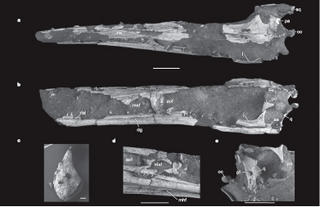Antiguo dromaeosaurido de Sud América

The earliest dromaeosaurid theropod from South America
Peter J. Makovicky1, Sebastia´n Apesteguı´a2,4 & Federico L. Agnolı´n3
The evolutionary history of Maniraptora, the clade of carnivorous
dinosaurs that includes birds and the sickle-clawed Dromaeosauridae,
has hitherto been largely restricted to Late Jurassic and
Cretaceous deposits on northern continents. The stunning Early
Cretaceous diversity of maniraptorans from Liaoning, China1–3,
coupled with a longevity implied by derived Late Jurassic forms
such as Archaeopteryx, pushes the origins of maniraptoran
lineages back to Pangaean times and engenders the possibility
that such lineages existed in Gondwana. A few intriguing, but
incomplete, maniraptoran specimens have been reported from
South America4–8, Africa9 and Madagascar10. Their affinities
remain contested11–13, however, and they have been interpreted
as biogeographic anomalies relative to other faunal components of
these land-masses. Here we describe a near-complete, small
dromaeosaurid that is both the most complete and the earliest
member of the Maniraptora from South America, and which
provides new evidence for a unique Gondwanan lineage of Dromaeosauridae
with an origin predating the separation between
northern and southern landmasses.













<< Home